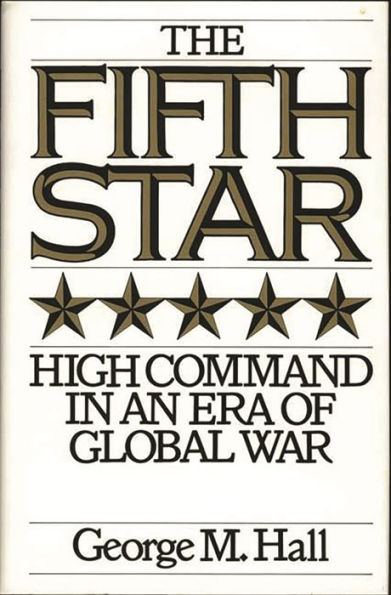The Fifth Star: High Command in an Era of Global War
In modern times, ten Americans rose to five-star rank: Pershing (who chose to wear only four stars), Leahy, Marshall, King, Arnold, MacArthur, Nimitz, Halsey, Eisenhower, and Bradley. In concert with the Roosevelts, Wilson, Truman, and Sir Winston Churchill, they were at the helm as the world transformed from the machinations of regional despots to an era of global war. With few exceptions, these men exercised their responsibilities with remarkable integrity and ability. The first part of this book reviews the biography and military highlights of each five-star; the second analyzes and compares the ten to identify common features of the elements of command and leadership.
While studying the careers of these distinguished men, Hall also provides an insight into the analysis of war. He explains that war operates on five levels of perspective: heroism, tactics, operations, theaters, and national purpose. When these levels conflict, even the best leaders are fortunate to escape with their reputations intact. This volume details how these commanders achieved success by understanding and properly maintaining these different perspectives almost unfailingly. Consequently, they reached the pinnacle of power in the military profession.
"1111520246"
While studying the careers of these distinguished men, Hall also provides an insight into the analysis of war. He explains that war operates on five levels of perspective: heroism, tactics, operations, theaters, and national purpose. When these levels conflict, even the best leaders are fortunate to escape with their reputations intact. This volume details how these commanders achieved success by understanding and properly maintaining these different perspectives almost unfailingly. Consequently, they reached the pinnacle of power in the military profession.
The Fifth Star: High Command in an Era of Global War
In modern times, ten Americans rose to five-star rank: Pershing (who chose to wear only four stars), Leahy, Marshall, King, Arnold, MacArthur, Nimitz, Halsey, Eisenhower, and Bradley. In concert with the Roosevelts, Wilson, Truman, and Sir Winston Churchill, they were at the helm as the world transformed from the machinations of regional despots to an era of global war. With few exceptions, these men exercised their responsibilities with remarkable integrity and ability. The first part of this book reviews the biography and military highlights of each five-star; the second analyzes and compares the ten to identify common features of the elements of command and leadership.
While studying the careers of these distinguished men, Hall also provides an insight into the analysis of war. He explains that war operates on five levels of perspective: heroism, tactics, operations, theaters, and national purpose. When these levels conflict, even the best leaders are fortunate to escape with their reputations intact. This volume details how these commanders achieved success by understanding and properly maintaining these different perspectives almost unfailingly. Consequently, they reached the pinnacle of power in the military profession.
While studying the careers of these distinguished men, Hall also provides an insight into the analysis of war. He explains that war operates on five levels of perspective: heroism, tactics, operations, theaters, and national purpose. When these levels conflict, even the best leaders are fortunate to escape with their reputations intact. This volume details how these commanders achieved success by understanding and properly maintaining these different perspectives almost unfailingly. Consequently, they reached the pinnacle of power in the military profession.
95.0
In Stock
5
1

The Fifth Star: High Command in an Era of Global War
248
The Fifth Star: High Command in an Era of Global War
248Hardcover
$95.00
95.0
In Stock

Product Details
| ISBN-13: | 9780275948023 |
|---|---|
| Publisher: | Bloomsbury Academic |
| Publication date: | 03/30/1994 |
| Pages: | 248 |
| Product dimensions: | 6.14(w) x 9.21(h) x 0.62(d) |
| Lexile: | 1240L (what's this?) |
About the Author
From the B&N Reads Blog
